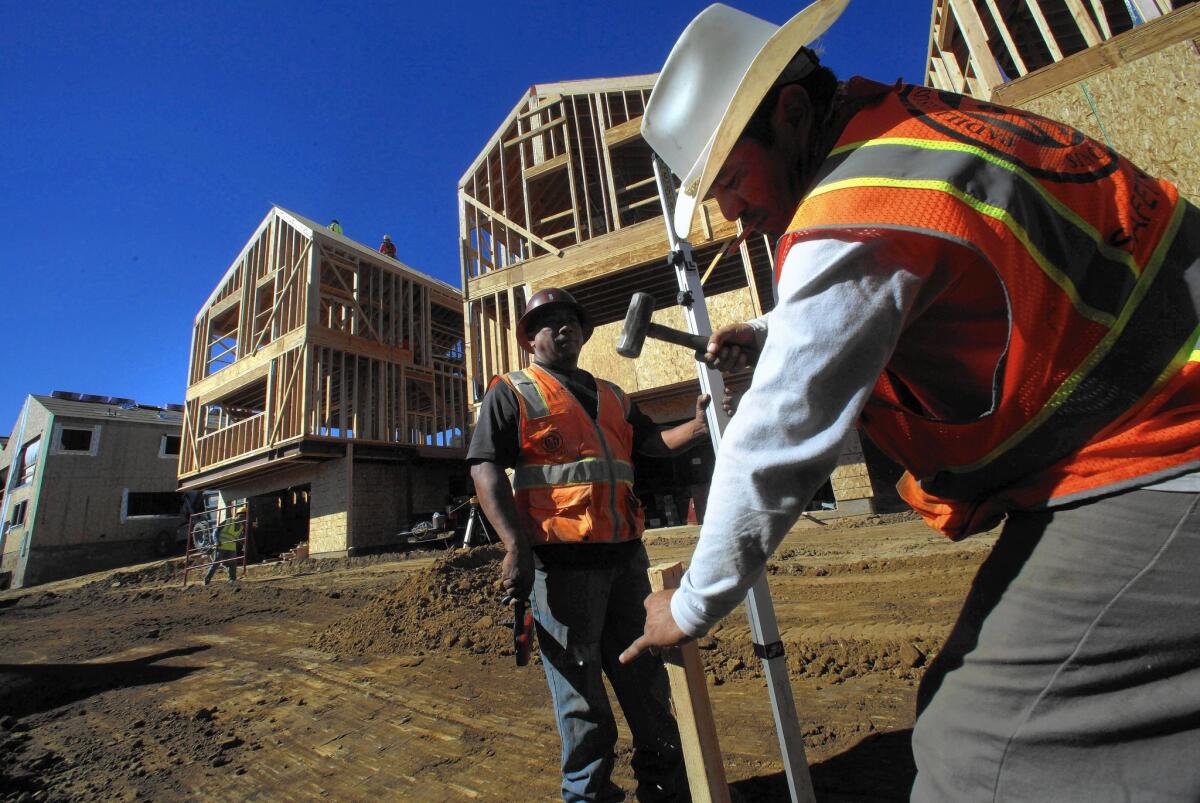Hitting Garcetti’s goal of 100,000 new homes by 2021 won’t be easy

- Share via
With Los Angeles facing one of the nation’s worst housing crunches, Mayor Eric Garcetti urged the city to pick up the pace on home building and add 100,000 new homes by 2021.
But how?
Hitting the goal Garcetti laid out in a speech last week would mean adding more homes in Los Angeles in each of the next seven years than the city has added in all but one of the last 25.
That will require a grab bag of solutions, including creating dense hubs around transit stations, opening up backyards to extra homes and clearing the city’s sclerotic permitting process, developers, urban planners and housing advocates say.
And, they all agree, it’s long overdue.
“This is a gigantic challenge,” said Alan Greenlee, executive director of the Southern California Assn. of Nonprofit Housing. “We historically have not kept up, and the problems are only getting worse.”
While Garcetti’s speech outlined broad ideas about cutting red tape and funding affordable housing, spokespeople for his office said they’re still rolling out specific proposals.
Some include projects already underway, such as rewriting L.A.’s 1940s-era zoning code and streamlining the building permit system. And Thursday, Garcetti asked the Metropolitan Transportation Authority to inventory its property for potential affordable-housing sites and set a goal that 30% of units built on Metro-owned land be affordable.
Building transit-oriented housing is a good start, developers say. So is developing in large dense chunks where there’s opportunity, be it downtown — where more than 21,000 apartments and condos are being built or proposed — or at Warner Center, where plans call for nearly 4,000 condos and apartments.
“We need to embrace density in whatever ways we can,” said Will Wright, director of government and public affairs at the L.A. chapter of the American Institute of Architects.
But in a built-out city where so much of the housing is more suburban in style, there’s opportunity in backyards too.
Dana Cuff, director of cityLAB at UCLA’s School of the Arts and Architecture, has spent years studying so-called backyard homes — or “granny flats” — that can house a renter, an in-law or a still-at-home 20-something. They exist all over town, often illegally, and regulations make them hard to build in many neighborhoods. Permitting more could go a long way toward helping L.A.’s housing shortage, Cuff said.
“There’s a half-million single family-houses in the city of Los Angeles,” she said. “If 10% of those added a granny flat, we’d be halfway [to Garcetti’s goal]. And it’s free land.”
In addition, Los Angeles has many vacant lots and other underused sites that could hold more housing, such as the Echo Park hilltop where development firm Local Construct is putting 18 townhouses on a one-acre lot that previously held a handful of bungalows.
The project is zoned under the city’s small-lot subdivision ordinance, which enables denser, townhouse-style buildings on small chunks of ground. The program has become more popular in recent years as developers aim to squeeze more units onto infill sites, but it has also drawn growing criticism from neighbors who say these projects are often too dense for their surroundings.
The Echo Park project, dubbed “Blackbirds” for the homes’ dark peaked roofs, drew some of that flack too. Although Local Construct aimed from the start to design a project that fit in, the neighbors took some convincing.
“I went door to door. We had a town hall meeting,” said the firm’s co-president, Casey Lynch. “There was a lot of skepticism and angst.”
Construction launched in April, with sales set to start next spring. The time spent on public hearings, permitting and pushing a complicated development through various city departments added up, Lynch said.
“Start to finish it’ll take three and a half years to deliver this project,” he said. That adds costs.”
Prices haven’t yet been set, but Lynch said they’ll be in line with the neighborhood, where sale prices averaged $588 a square foot in the third quarter, according to CoreLogic Dataquick. That would put a 1,400-square-foot model at about $823,000.
More modestly priced projects are even harder to pull off, affordable housing advocates say. They face comparable costs of land, construction and permitting, without the market-rate payoff. Yet public subsidies to close that gap have dropped sharply as federal programs were cut back and state bond funds dried up.
In his speech last week, Garcetti said he would work with leaders in Sacramento to restore state housing funding, pointing to money set aside in California’s new cap-and-trade program, which auctions permits for greenhouse gas emissions, and a $600-million bond issue for veterans housing
Some in City Hall are trying to carve out local cash too. Councilman Mitch O’Farrell has been pushing a measure that would shift 10% of L.A.’s so-called “boomerang funds” — tax revenue the city is now receiving after redevelopment agencies were dissolved — to an affordable housing fund. It would probably amount to just a few million dollars a year, but it’d be a start, he said.
Greenlee said that any fix to L.A.’s affordable housing crunch will require a wide range of solutions, from preserving existing low-cost and rent-stabilized housing to adding more Section 8 vouchers for low-income renters.
“I represent an industry full of folks who can build like crazy if they have the right resources,” he said. “But building our way out of this is going to be a tough nut.”
Still, in a growing city, building more homes is crucial. Since 1991, Los Angeles has averaged a net gain of just 5,500 housing units a year, according to figures from the California Finance Department. In that time the city topped 12,500 — the pace needed to meet Garcetti’s goal — only once, in 2008
But if the goal is to lower the cost of housing, even the fastest pace of construction in a quarter-century may prove entirely too slow, Wright said.
“At what point do we start to get relief from how much it costs to live in L.A.?” he said. “One hundred thousand units. Is that enough?”
Twitter: @bytimlogan
More to Read
Sign up for Essential California
The most important California stories and recommendations in your inbox every morning.
You may occasionally receive promotional content from the Los Angeles Times.







